

New Delhi is a city of contrasts, with centuries-old temples beside glass towers, quiet colonial avenues next to buzzing markets, and flavours that shift from luxury dining to roadside chaat. Life here can be as affordable or as indulgent as you make it, and that’s what makes Delhi so dynamic for expats, freelancers, and remote workers.
Living in New Delhi means navigating both the modern and the traditional, from leafy neighbourhoods in South Delhi to the energy of Connaught Place. The cost of living varies widely depending on where you stay and how you spend.
Finding a home in Delhi is all about choosing your pace and comfort level. Expats tend to favour the safer, greener areas in South and Central Delhi, while more affordable options are available in the city’s outer districts or Gurgaon (now Gurugram).
Here’s how rent typically looks across neighbourhoods:
The expat favourite. South Delhi combines convenience, cafés, and leafy residential streets. Areas like Greater Kailash and Defence Colony are upscale and well-connected, while Hauz Khas offers a younger, artsy feel with boutique apartments and nightlife.

Historic, convenient, and full of colonial charm. Central Delhi is ideal for those who want quick access to embassies, offices, and cultural attractions. It’s pricier, but living here means being in the thick of the action.

Modern and business-focused. Gurgaon is home to corporate offices, luxury malls, and newer high-rise complexes. It’s popular with professionals working remotely or in tech and finance. The infrastructure is modern, and many apartments come with gyms and pools.

More affordable and family-friendly. These districts are great for long-term residents seeking lower rents without leaving the city. Infrastructure is improving, and access to metro lines makes commuting manageable.

For those who prefer space and calm. These satellite cities are connected by metro and offer newer developments with lower rents, ideal for remote workers or families.
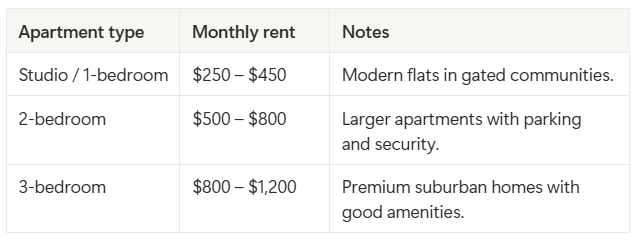
New Delhi is a city that moves fast (sometimes too fast). Between a buzzing metro, the endless flow of rickshaws, and the constant hum of traffic, getting around is an adventure in itself. For expats, navigating Delhi’s transport network can feel overwhelming at first, but it quickly becomes second nature.
Delhi Metro
Clean, efficient, and air-conditioned, the Delhi Metro is the backbone of the city’s public transport. It connects nearly every major area, from Connaught Place to Gurgaon and Noida. It’s the most reliable way to escape traffic and travel long distances quickly.
Autorickshaws
The green-and-yellow autos are everywhere in Delhi. They’re perfect for short to medium trips and cost less than taxis.
Ride-hailing apps (Ola, Uber, Rapido)
Most expats rely on ride-hailing apps for convenience and cashless payments. Both Ola and Uber are widely used, and Rapido offers affordable bike rides for solo travellers.
Taxis (traditional cabs)
Traditional black-and-yellow taxis still exist, but they’re far less common than before. Most travellers now prefer app-based rides for safety and reliability.
Buses
Delhi has an extensive bus system run by the Delhi Transport Corporation (DTC) and private operators. Buses are cheap, frequent, and cover nearly all parts of the city. Many are now air-conditioned.
Driving and car rentals
Driving in Delhi is not for the faint-hearted. Traffic is heavy, rules are loosely followed, and parking can be a challenge. Still, many expats rent or hire drivers for convenience.
Two-wheelers and scooters
Motorbikes and scooters are popular for short commutes, especially in areas with tight traffic. Apps like Rapido also rent bikes.
Walking and cycling
Delhi isn’t the most pedestrian-friendly city, but areas like Lutyens’ Delhi, Connaught Place, and Lodhi Garden are pleasant to explore on foot. Some new neighbourhoods also have dedicated cycling tracks.
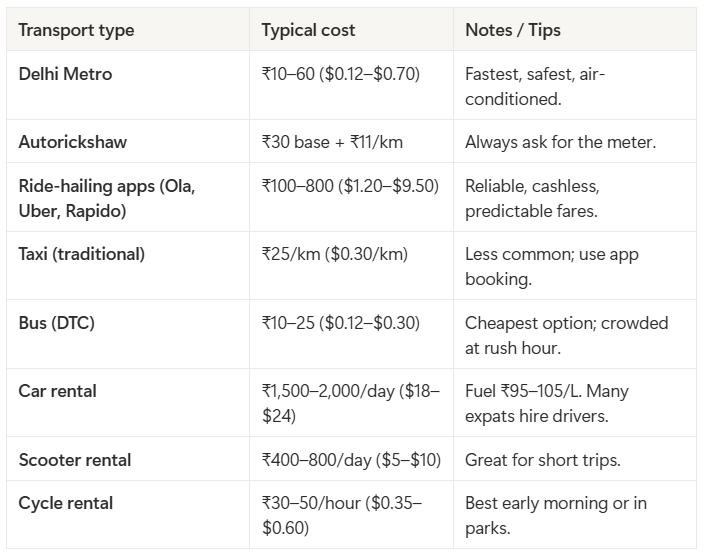
I love that food in New Delhi is a daily celebration of flavour, from sizzling street food at India Gate to elegant fine dining in Khan Market or Aerocity. You can live on spicy chaat and parathas or enjoy global cuisine in expat-favourite cafés.
Restaurants
Eating out in Delhi ranges from quick roadside snacks to multi-course gourmet meals. Street food is cheap, delicious, and everywhere, while cafés and restaurants in South Delhi or Gurugram offer trendy, international menus.
Delhi also has a thriving café culture, with modern coffee houses and coworking cafés in places like Lodhi Colony or Saket. Coffee and pastries usually cost ₹200–400 ($2.50–$5).
Supermarkets and markets
Grocery shopping in Delhi depends on how and where you shop. You can save a lot by buying from local mandis (fresh markets), or choose the convenience of large supermarkets that stock imported items for expats.

The tip is always to shop in a mix of both: mandis for fresh produce, and premium stores for imported cheese, wine, and cereals. Imported goods are significantly pricier due to taxes, so switching to local brands can save a lot.
For one person
Total monthly food budget: $280–520
Enough to cook regularly, enjoy street food, and still dine out a few times a week without stretching your wallet.
For a couple or small family
Total monthly food budget: $560–920
This covers a comfortable mix of home-cooked meals, family lunches, and the occasional treat at Delhi’s upscale restaurants.
New Delhi’s utility costs are generally reasonable, though electricity bills can fluctuate quite a bit between seasons, especially during the hot summer months when air conditioning runs constantly. Here’s what you can expect monthly:
Electricity
Electricity is the biggest variable in your utility budget. Summers (April–August) can drive bills up significantly due to air conditioning, while winter usage drops sharply.
Water
Water is inexpensive but not always consistently supplied in every area — especially in older buildings. Many apartments in Delhi have water tanks or rely on tankers for refills.
Gas
Most homes use piped natural gas (PNG) for cooking, but in some areas, LPG cylinders are still common. Both are affordable and widely available.
Internet
Internet coverage in Delhi is excellent, especially in residential areas and coworking hubs. Fibre broadband is standard, with competitive speeds and reliable service.
Mobile/Cell phone
Mobile data is very cheap in India — some of the lowest prices in the world. Both prepaid and postpaid plans include generous data allowances.
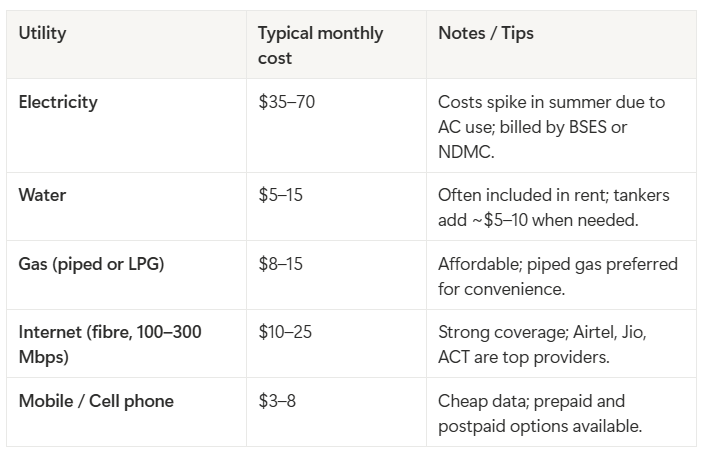
Healthcare in New Delhi offers a wide range of options, from low-cost public hospitals to world-class private facilities that attract patients from across the globe. The city is a major hub for medical tourism, offering high-quality treatment at a fraction of Western prices.
Public healthcare
India’s public healthcare system, run under the National Health Mission, provides basic medical services at government hospitals and clinics. While affordable, these facilities are often overcrowded and may lack modern equipment or English-speaking staff.
Public hospitals like AIIMS (All India Institute of Medical Sciences) are among the best in the country, but expats generally prefer private options for reliability and efficiency.
Private healthcare and insurance
Private healthcare in New Delhi is excellent and affordable by international standards. Leading hospitals such as Fortis, Apollo, and Max Healthcare provide English-speaking doctors, advanced treatments, and modern facilities.
Private health insurance is highly recommended for expats and long-term residents. Most international providers, like Cigna, Allianz, and HDFC ERGO**,** offer flexible plans that include both local and global coverage.
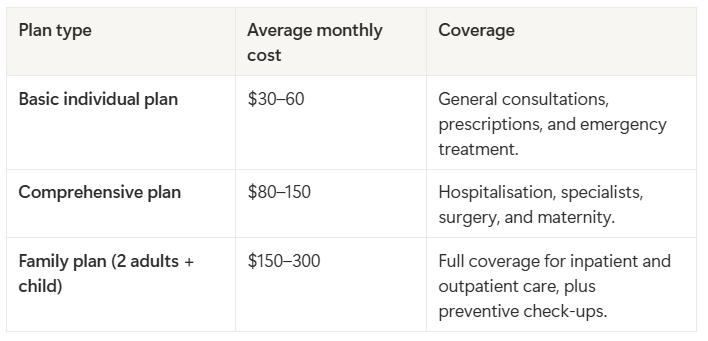
Tip: Most doctors in private hospitals speak fluent English, and appointments can often be booked online or via apps. Pharmacies are plentiful, and generic medications are widely available, making day-to-day healthcare both convenient and inexpensive.
New Delhi is one of Asia’s most dynamic capitals, offering a blend of history, food, culture, and modern convenience. While the city can be as affordable or expensive as you make it, your monthly costs will largely depend on your neighbourhood and lifestyle choices, like in most cities.
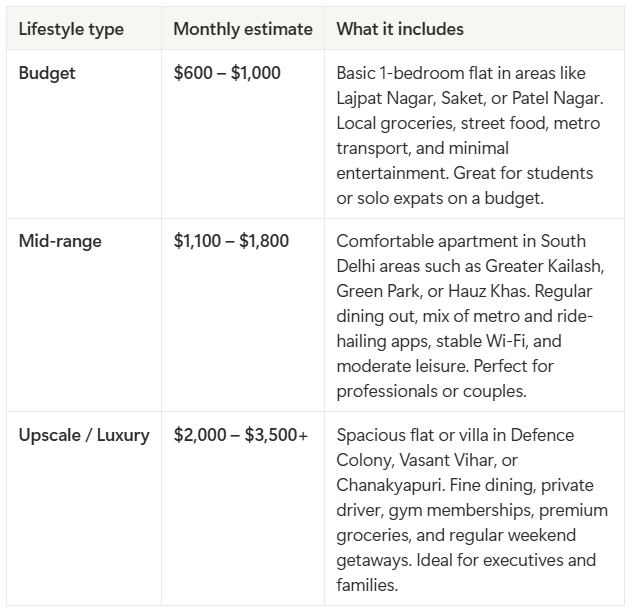
You can live comfortably in New Delhi for around $1,200–1,600 per month, though costs rise sharply in high-end neighbourhoods or if you prefer imported goods and Western-style amenities.
From rooftop bars in Hauz Khas to the calm of Lodhi Gardens, New Delhi blends heritage and modern living in a way few cities can. For expats and freelancers earning abroad, the city offers an incredible quality of life at a fraction of Western costs.
With Grey, you can receive international payments in USD, GBP, or EUR, convert them at competitive rates, and withdraw INR ****directly to a local account.
Open your Grey account today and make living in New Delhi as rewarding financially as it is culturally.




.svg)
Back to top